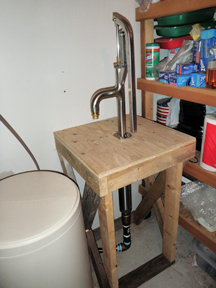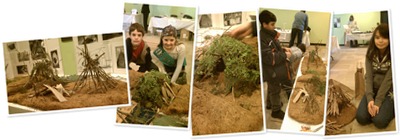We will be on Bailey Avenue this Saturday July 18th at Ridgefield's Super 70's Summerfest...
The Underground House
I just want to give a shout out to friends and clients in Virginia who are building an underground house. This amazing and interesting couple with 3 grown children are basically building this house themselves. We helped them with some early design work but basically Kim and Bill are driving this ship.
Imagine the Teletubbies beautiful grass covered dome house, change the shape a bit, add a garage and this is what you get. Click on this link to Kim's Blog to read all about it. Be sure to check back to earlier posts to read all about the hows and why!
Wilton Go Green Festival!
Come see us this Sunday May 5th at the Wilton Go Green Festival! Wilton has one of the best and most interesting Green Festivals around. It has been well established over the years by a truly dedicated team. We hope to see you there! The weekend promises to be beautiful!
11-4 pm, Sunday May 5th, Town Center, Wilton CT

THIS IS AN ARTICLE FROM CT MAGAZINE APRIL '13 ISSUE ~ Darien LEED Home Featured
When Hurricane Sandy slammed into Connecticut late last October, 94 percent of Connecticut Light & Power’s 8,000 customers in the town of Darien lost power. Fifty streets in the coastal community were inaccessible to restoration crews; 20 homes were eventually declared uninhabitable. The power—and with it heat, lights and appliances—stayed off for as long as two weeks. As temperatures dropped, one of the worst storms in the state’s history cast the affluent Fairfield County community into a cold, dark gloom...
Walking Forward Into The Past
Below is an article put out by The Taft School regarding the project we are workign on there!
http://www.taftschool.org/alumni/onephotoleft.aspx?storyname=59north
A Green Home
Walking Forward Into the Past
03/23/2013

Proposed house design in Greek Revival style

Trillium ArchitectsAt boarding school, a house is more than just a home. It’s also a place to host team dinners and advisee feeds—and for most faculty, it’s just a hop, skip and a jump from the classroom or athletic field.Roughly a third of the Taft faculty live in dormitory apartments, but after a few years of late night check-ins and the occasional fire drill, many faculty (frequently with growing families) move into nearby campus housing. The school now owns about 35 homes (some are two-family) in the neighborhood, most of them adjacent to the playing fields.Last summer the school renovated the Rectory building (acquired with Woodward Chapel) and this summer plans to build a state-of-the-art green home designed by Architect Elizabeth DiSalvo, Trillium Architects, a leader in the field of residential green building, thanks to a gift to support the school's commitment to faculty housing and environmental stewardship."This project perfectly embodies two key strategic priorities," says Headmaster Willy MacMullen '78, "improved faculty housing and a commitment to environmental stewardship. We are so lucky that we received a generous grant from a Taft family to make this possible."Current plans are for a 2,400 square foot, two-story home with two-car garage, 3 bedrooms and 2.5 baths. A new foundation will be located further back from the road and oriented to optimize use of passive and active solar energy (see box below for more details). The school had originally hoped to renovate the existing home on the site, but discovered numerous problems and began to consider the benefits of building a new home that could be at once historically sensitive to the neighborhood and also a model of environmental sustainability."What Taft is doing with the plan for this new home," says DiSalvo, "is something I call 'walking forward into the past.' I got this term from a Native American in New Mexico. Basically it means using the technological advances we have to day to revive the intentions of the past. In housing that means getting back to nature and building intelligently based on what nature tells us and gives us. For example, the sun warms us naturally, therefore, it makes sense to turn a house toward the sun to let the low winter sun in and provide overhangs to shade us from the hot summer sun. This sort of building was obvious when people lived in tune with nature and the seasons. Modern technologies have brought us away from that knowledge. Why not use the wisdom of the past to form our houses and then add the significant benefits of modern technology to make a house that can be close to net zero and last for generations to come. And when its long life cycle is done, it can naturally biodegrade and become part of the earth again. This is what Taft is doing with the house at 59 North Street."Before proceeding, Taft consulted with the town historian, who discovered no architectural or historical significance to the home, and then, following all permitting requirements, presented the design to the Watertown Historic District Commission, which approved the new plan unanimously.Still, the proposed removal of the home stirred some controversy after the public hearing.“Taft followed all the required procedures and is tremendously excited about building a home that will be beautiful, efficient and responsible,” says Headmaster Willy MacMullen ’78."The vote of the Commission was unanimous," wrote Jean C. King, chair of the Watertown Historic District Commission. "The Commission consulted with Mr. John Pillis, the town historian, during its deliberations and Mr. Pillis agreed with our decision."Taft has not razed any homes in the Historic District since the district’s creation. The Annex was the last known structure removed, now 50 years ago—for fire safety concerns.The home at 59 North Street bears little resemblance to its 19th-century original. What is visible is likely a 1920s creation. Not much remains of the home's historic character after repeated additions and renovations."In every era of history, houses have been built to higher and lower quality levels," says Di Salvo. "Some are truly gems, fantastic examples of the design, technologies and riches of their age. Others are utilitarian structures that are erected because someone needs a quick and inexpensive shelter. Should we save everything ever built more than 100 years ago? Not necessarily. If we fast forward 100 years would you expect our grandchildren to save a poorly built '70s ranch or a very poorly built '80s McMansion simply because they are old?" "The home, while old, has been renovated and added on to over the years," says Business Manager Gil Thornfeldt, "and the current house could not feasibly be renovated to provide a safe, environmentally conscious home for a family."Taft School actively seeks to preserve the town’s historic character and has demonstrated that commitment through the preservation of the old town library (now Walker Hall), Christ Church (Woodward Chapel)—both of which are still used to host events that are open to the public—as well as the Rectory and another home on North Street that was renovated several years ago. The Academy Building and the Woodward Chapel Annex are both scheduled for renovations this year. A rear view of the current structure at 59 North Street, which shows multiple additions to the original structure.
Green Features
The goal of a HERS (Home Energy Rating System) Score less than 30, optimally less than 20. High R-Value with very low air infiltration and little thermal bridging make the heating and cooling of the house incredibly efficient, requiring very little fuel.
Building Envelope:
Walls: R45 (code requires R21) double stud walls filled with 12" dense-packed cellulose
Roof: R65 (code requires R38) underside sheathing ‘flashed’ with closed-cell foam insulation (approx. 3” = R20) and filled with dense-packed cellulose approx. 12" thick (R 45)
Basement: R20 (code requires R10) 3" closed-cell foam with drywall over stud framing
Slab: R28 (code requires R10) Slab will have 4" EPS foam below it.
Windows: R5 / U.2 Min (energy star suggests and code requires R3.5/ U.28)
Air Infiltration Goal of 1.0 ACH@50 Pascals airflow Maximum
HVAC Equipment
-Super high-efficiency Ductless Mini-splits (2) for heating and cooling
-ERV (Energy Recovery Ventilator) to re-coup heat and moisture from outgoing air
-High Efficiency Gas (or propane) on demand Hot Water Heater with Solar Thermal Back up
-High efficiency, super low emission wood stove for power failures or extreme cold spells.
Electrical
-Photovoltaic solar panels for powering lights, outlets, etc., and Minisplit heating and cooling system with possible battery backup.
-Ceiling Fans for circulation of air in each bedroom and major living space
-LED Lights throughout
-Energy Star rated Appliances
Water
-Collect all water from the roof in underground holding tank connected to a drip irrigation system for the adjacent school garden.
Materials
-Painted cedar shingle exterior, applied as "rain screen," an old-fashioned method (rarely practiced now) that allows for a continuous airspace behind the shingles to keep them dry yearround. The ability to get wet and then dry makes the shingles and the paint job last a very long time.
-Strive for natural and sustainable materials for the interior and salvage materials, like wood flooring, from the existing home where possible
Ground Cover and Plantings
-Water-permeable drive and walkways of stone or gravel to reduce runoff
-Native plantings that require no active watering
Want to be OFF the GRID for that next STORM??
I DO!! I have found 3 super cool products this week that I plan to get for my own house.
- One is a stove that cooks your dinner and charges your small electronics!
- The second is a hand pump that you can hook up directly to your normal well!
- The third is an Awesome version of a wood firebox insert!
Here is a bit of info about each:
1. (COOKING + CHARGING) The Biolite Stove http://www.biolitestove.com/
What do you need when you are out of power for a week? Water, heat, a way to cook. Then also nice would be a refrigerator, an electrical source and a hot shower.
Biolite makes both the Camp Stove and the Home Stove that solve two problems- cooking and charging small electronics.. Currently only the Camp Stove is available to the general public. The Home Stove (which is the one I can't wait to get!) is still in testing- mostly in 3rd world countries in need I believe- and is not yet able to be purchased. A good friend of mine who is a leader in the green building movement has the Camp Stove and loves it.
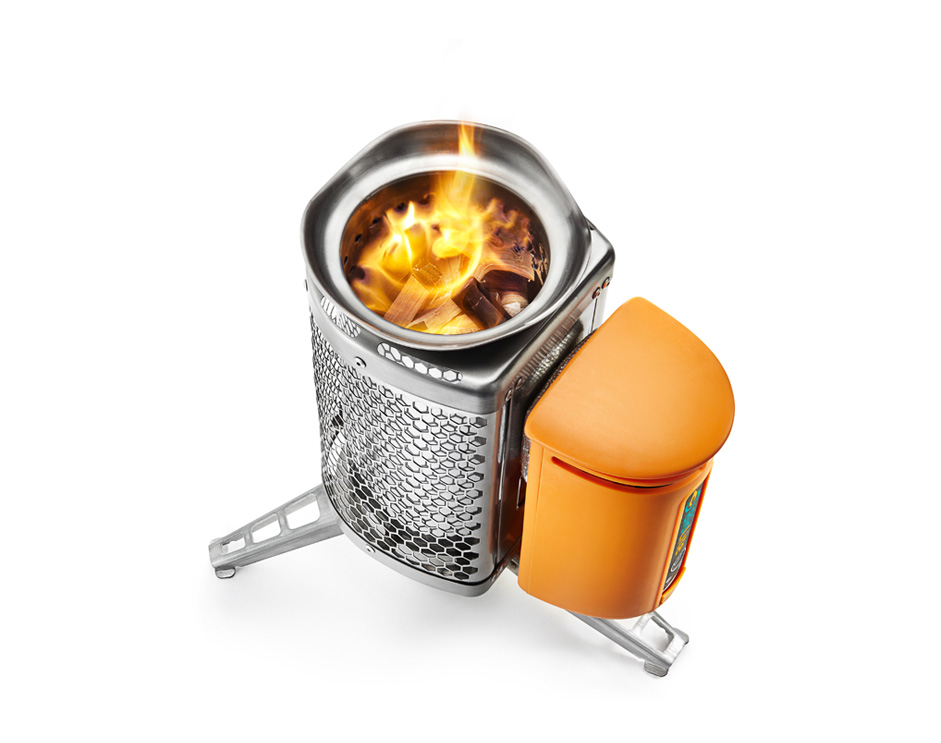
Here is a blurb form the company:
Using our patent-pending technology, BioLite has created a low-cost biomass cook stove that, by converting waste heat into electricity, reduces smoke emissions by up to 95% while simultaneously providing users with the capability to charge mobile phones and LED lights.
2. (WATER) The Bison Hand Pump http://www.bisonpumps.com/
I have been thinking about this for the last year. The water problem is usually solved- in our house- by a giant bathtub filled with water before the power goes. This is not a bad answer and a jacuzzi tub of water can last 4 people for a week of cooking, cleaning and toilet flushing. But WOW! wouldn't be great to just be able to pump that water sitting down there in your well??
These guys have made that a possibility. Here is a blurb from the Bison web site:
We want to emphasize that Bison Deep and Shallow Well Hand Pumps can be installed in the same casing as your existing electric submersible or jet pump in nearly any situation. There seems to be some doubtful conversation out there that this cannot be done. Please give us a call and our sales and technical staff will guide you through your specific installation. As the ol' saying goes "Never say never"!
3. (HEAT) The Wittus Phenix Green Wood Insert http://www.wittus.com/
I love this stove. Here we have an alternative source of heat that is perfect for a blackout situation. It uses wood in a super clean way. It pumps out a lot of btu's very efficiently. It can be ducted to serve more remote parts of a house and it can be controlled by a thermostat. It brings in 100% outside make up air AND it looks great. The Fireplace Insert uses natural convection to disperse the heat and does not rely on a fan. Many of the high efficiency stoves that are installed really need the fan to make the heat fill the space. I appreciate this low tech/ super efficient answer to the heating problem. Plus the fact that it is operates with much lower levels of pollutants makes it a truly acceptable answer to the problem. AND since all have a lot of trees and wood around after the last hurricanes, it seems like a no brainer.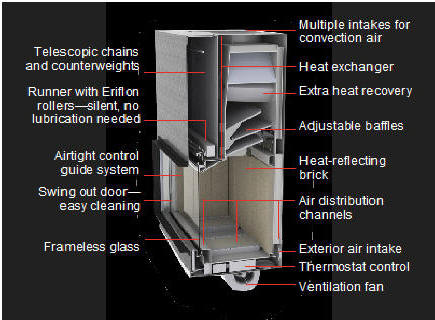
From Wittus:
The Phenix Green zero-clearance built-in fireplaces from Bodart & Gonay of Belgium set a new standard for wood burning stoves. Equipped with the latest retractable door technology, it allows the user to enjoy the fire with the door open or closed.
With the door lifted, you enjoy the warmth of a genuine open fire. With the door closed, you get a full view through the panoramic window and with the maximum efficiency range of 76%—82% and exceptional heating power.
Phenix Green are available in four models: the 75, 85, 95, and the 120. The technological advances along with low CO and particulate emissions makes the Phenix Green fireplace an ecologically friendly product.
All models include these special features:
- multi-ducting capability, which enables heat transfer in up to 6 additional rooms
- a linear, seamless steel frame
- an upward lifting/forward tilting door feature that make it easy to clean the glass viewing window
- the outside air system uses 100% direct air intake
- the thermostat keeps the temperature regulated
- choice of Class A or Heatilator chimney system
- an optional fan capability.
House Design and Energy Efficiency
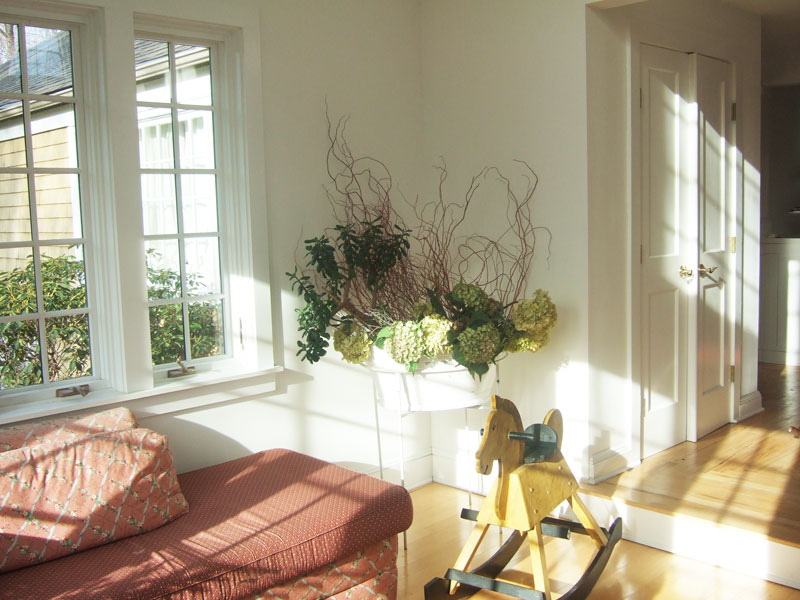 Every so often I get a question from someone and I feel that the answer is worth sharing with all similarly curious minds~ here is one now:
Every so often I get a question from someone and I feel that the answer is worth sharing with all similarly curious minds~ here is one now:
'How does the design of the house compliment the energy-efficiency and environmentally friendliness of the house? '
There are many ways that the design of the house can compliment energy-efficiency and environmentally friendliness.
- Size of the house- smaller means less to heat and cool, less to maintain, less materials, less cleaners. All of the houses we design are made to use natural materials, low or no vocs and to be extremely low maintenance, but smaller does mean less of everything and so a lesser burden on the environment and because you have to heat and cool less, a smaller carbon footprint.
- We make houses smaller by eliminating useless rooms and acknowledging 'how' people live so that the actual use of the house becomes more efficient. For example we get rid of the formal dining and living rooms that are almost never used. We design open flowing public areas and more intimate and cozy quiet spaces (such as bedrooms and dens or reading nooks). We also try to make every wall in the house a 'useful wall' either as a book case or a wall of built in cabinets or a book shelf that floats in the room as a screen and not really a wall. All of these features make for a house that is so useful and so full of storage spaces that our clients do not miss the big house full of empty and useless space. All of these features also add up to a house that is resplendent with charm and nooks and a variety of types of spaces to suit your mood. (And one thing I always say is that a well loved house is a well cared for house, a well cared for house is a long lived house and a long lived house is the most sustainable house one can ever build.)
- The orientation of the house can optimize the energy use of the house (heating cooling and electric lighting). In our climate we want to turn a house to face south when at all possible. We want to try to capture all of the southern light we can in the winter and then shade it in the summer. This can easily be done by carefully planning the placement and size of windows and the placement and size of overhangs and sun shades. To super optimize the passive solar qualities of a house we also want to make the walls and basement and roof super insulated and resistant to air infiltration. basically imagine a large rectangular thermos with its open side facing south and sealed with a glass wall. This is a really simplified version of what wee are talking about but the idea is that the house is so well insulated and oriented that it is extremely easy to heat and cool and then extremely easy to keep warm or cool once it is heated or cooled. the orientation and dispersal of windows in relation to rooms can also optimize natural lighting and reduce the need to turn on the lights for most of the day.
- The shape of the house also influences this. The less surface area the better. It turns out the most efficient shape for a house is a simple rectangle, 2 stories tall yet not too long and rectangular. Something between a cube and a long rectangle. The Darien house achieves something close to the optimum shape....its its not a pure rectangle but the volume is right. (There is a method of design and building called Passive House - started in Germany- that has been researching this for year- the optimal size and shape of a house, the percentage of windows to wall area, the point at which more insulation doesn't make sense (this is a much higher number than most people would think but there is a limit!) Those of us who have been building this way for years and years use the passive house model as the ultimate goal, each house we do is generally falls somewhere on the spectrum on the way to passive house. We have 2 actual passive houses on the boards now, but not many have been built in the us yet. Maybe 50?)
- The location of utilities and fixtures. Plumbing, electric and HVAC all work more efficiently if the locations are lined up and placed to make the runs short (so ducts, pipes wires go the shortest distance possible.) This saves money not only in materials but forever in the operational costs of the house. This solves minor problems like turning on the water and letting it run for 3 minutes while waiting for the hot water to arrive. At the Darien we made sure all of the runs were kept short. There are LEED points that are achieved only by meeting certain requirements for length of runs. We achieved these points.
- How to survive a power outage. With all of our houses we make sure that the clients have everything they need in case of emergency. Almost all of our houses get a high efficiency gas or wood burning stove that can heat most if not all of the house. Usually these items are back up heat sources (because people have become accustomed to just adjusting the thermostat and not putting wood on a fire) but they could be used as the sole source of heat. We have designed 2 houses in the last few years in which the houses were so small and so well insulated that the clients just use their high efficiency gas fireplace insert to heat the house. We also make sure that the client will have a source of water. This can be a generator powered water pump or it can be a large bathtub that is filled before the power goes out. We also make sure they have a stove they can cook on. We like to put in gas stove top so that one can always lite the burners and cook. I say a house that has a good fireplace, a large tub and a gas stove top (or even an outdoor grill) can get through any power outage,even if it lasts a week. Of course you can also add a generator to the design (which we often do) but remember that they are loud and polluting and do run out of fuel .I have heard many a story of the family that has a large built in/ automatic generator but when the power goes out realizes that the tank is all but out of gas. And then they have to get in line with all of the other people waiting for gas delivery that could take days. I hate to ONLY be dependant on a generator. All off the grid options should be taken care of first, then a generator can be added. Solar panels can also be hugely useful in a power outage, even without battery back up. We really look at incorporating all aspects when designing for 'off the grid' living.
Happy New Year!
 Jojo and I have to say that we are glad 2012 is over! It was not a bad year, it is more that for the last 4 years of this horrid recession everyone has been saying 'this will not end until after 2012'. For some reason, I could not believe that. Back in '09 I was sure things would turn around in '10. In the summer of '11 things seemed like they might be turning around for sure! But alas...the recession HAS lasted for 4 years. Especially for all of us in the building industry and for many other creative fields.
Jojo and I have to say that we are glad 2012 is over! It was not a bad year, it is more that for the last 4 years of this horrid recession everyone has been saying 'this will not end until after 2012'. For some reason, I could not believe that. Back in '09 I was sure things would turn around in '10. In the summer of '11 things seemed like they might be turning around for sure! But alas...the recession HAS lasted for 4 years. Especially for all of us in the building industry and for many other creative fields.
2013, for me, represents H O P E and so far it seems to be working. We have some very exciting jobs just starting or on the horizon. We have two or maybe three Passive Houses in the works. One LEED home and a number of lovely little additions. At this moment we have a super green little modern house under construction on a lake in Ridgefield. And a fresh new office space to work from.
I wish for all of my friends in the building industry and all of those in other industries that have suffered these four years to have a prosperous, stress free and healthy next 4 years. And great happiness also to all of those who have not suffered. It is time to move forward!
A New Office in Ridgefield!
Trillium Architects is opening a new office location in Ridgefield. In pursuit of a simpler life and less of a daily commute, Elizabeth DiSalvo (principal and owner) has moved Trillium to Ridgefield, CT. Trillium will still serve the same client base of Fairfield and Westchester Counties and beyond and continue to focus on sustainable, energy efficient, beautiful, healthy homes.
Elizabeth grew up in Ridgefield and after 20 years living in Los Angeles, Colorado, and NYC, returned to Ridgefield to live in 2006. Trillium Architects was founded in South Norwalk in efforts to reach a broad client base and begin promoting green residential building. Now that Trillium is established as perhaps the most experienced green residential architecture firm in Connecticut, Elizabeth felt free to try to live a more sustainable lifestyle by locating her office close to home
So much of what we promote with our architecture is 'lifestyle' that enhances health and happiness as well as being good for the environment. Please do not hesitate to call for any of our services, no matter where your home is located. We look forward to working with you!
Re-post. AC units and Split System Heat Pumps
I get a lot of questions about cooling a home and HVAC in general. We specify air-to-air heat pumps on most of our jobs these days. They are similar to 'geothermal' which is air-to-water or air-to-ground heat pump technology, except you don't have to dig a hole in the ground.
We find the air-to-air heat pumps (also called 'splits or 'minisplits'), more efficient, much less expensive and less temperamental to install. People still say 'what about Geothermal?' Well, we specified our last geothermal systems about 4 years ago and I don't see any reason why would specify one again with these great units on the market!
Here is a great article by Alex Wilson of Environmental Building News that compares cooling options of all types:
Choosing an Air Conditioner
Understanding the options with room air conditioners, central air conditioners, and heat pumps.
 The outdoor unit of a Daikin mini-split air-sourceheat pump in Putney, Vermont. Click to enlarge.
The outdoor unit of a Daikin mini-split air-sourceheat pump in Putney, Vermont. Click to enlarge.Photo Credit: Alex Wilson
I have never owned an air conditioner, and I don’t have any immediate plans to change that. But if I did, what would I look for?
Answer:
For only occasional use and when you don’t want to spend more than $1,000, the options are limited to room air conditioners, which are most commonly installed in windows. These cool the rooms in which they are installed, though in a small house or one that’s very-well-insulated and tight, a single window unit may be able to cool much of the house.
Most room air conditioners are either installed in a double-hung window or in an opening in the wall specially created for the air conditioner. Special models are available that can be used in casement windows, though installation is trickier.
Window air conditioners are usually installed in the late spring or summer and removed in the fall. Because they don’t seal tightly in the window, they should not be left in place during the winter months, as they will result in cold drafts. Room air conditioners that fit into custom openings through the wall may be left in place as long as they are fairly well-sealing (most are not), and if they are removed the opening should be carefully sealed for the winter.
For whole-house cooling, central air conditioners or heat pumps are used, and chilled air is distributed through ducts. Heat pumps offer the advantage of being able to provide both cooling and heating—by reversing the refrigerant cycle seasonally. If I were putting in an air conditioning system and my budget allowed, I would install one of the new-generation mini-split air-source heat pumps. (Very significant for those of us in the Northeast, the cost of delivered heat from these heat pumps is usually lower than that of oil.)
Room air conditioner efficiencies and performance
Room air conditioner performance is reported as the Energy Efficiency Rating (EER), which is a measure of the energy output in Btus (British Thermal Units) per hour divided by the energy input in watts, assuming standard conditions (usually 95°F outside temperature and 50% relative humidity).
Federally mandated efficiency requirements for room air conditioners vary depending on size, ranging from an EER of 8.5 for models over 20,000 Btu/hour to 9.8 for models in the 8,000 to 14,000 Btu/hour size. To meet the Energy Star standard in these size categories, the EER must be a minimum of 9.4 and 10.8, respectively. The thresholds are somewhat more relaxed for the smallest units.
Today’s best room air conditioners have EERs over 11.5, but relatively few exceed 10.8.
SEER ratings for central air conditioners and heat pumps
Central air conditioners and air-source heat pumps in cooling mode are typically rated on a seasonal bases using the seasonal energy efficiency rating (SEER). This is the total seasonal cooling output in Btus divided by the watt-hours of electricity consumption.
Central air conditioners and air-source heat pumps must have SEER ratings of 13.0 or higher. On January 1, 2015, those standards are scheduled to be tightened. To qualify for the Energy Starstandard, central air conditioners and air-source heat pumps both must have SEER ratings of 14.5 for split systems (separate indoor and outdoor components) or 14.0 for packaged units.
The best central air conditioners and air-source heat pumps today have SEER ratings above 22.
Moisture removal with air conditioners
All air conditioners remove moisture, as described in last week’s blog. While there are no federal requirements or measurement standards for moisture removal, most manufacturers list moisture removal in pints of water per hour. As a first step, you must properly size an air conditioner to achieve good moisture removal (see below). If humidity is a problem, look for models that are effective at moisture removal. Models with variable-speed motors are typically more effective at moisture removal.
Discuss moisture removal with a dealer or air conditioning contractor. Your particular situation and humidity conditions may inform the product recommendations.
Sizing air conditioners and heat pumps
Particularly with central air conditioners and heat pumps, sizing is key to successful performance. With an oversized unit, frequent on-off cycling will occur, efficiency will drop, and moisture removal will be poor. Sizing requires carrying out detailed cooling load calculations; it is not something that should be done using rules of thumb. The sizing of ducting with a central unit is also very important, both for efficient operation and noise control.
Making decisions
A knowledgeable air conditioner salesperson should be able to help you pick out a quality room air conditioner. Insist on an Energy Star-listed model, ask about moisture removal, and then consider technical support, warranties, manufacturer reputation, and service in making your buying decision.
With central air conditioners and heat pumps, talk with air conditioning contractors and suppliers, but be aware that specific contractors may push only those products they are most familiar with or manufacturers they represent. The latest mini-split air-source heat pumps from such manufacturers as Mitsubishi, Daikin, Panasonic, and Fujitsu offer—in my opinion—the best option available today.
If the air conditioning contractor you contact doesn’t provide these systems, I would suggest that you seek out other contractors or suppliers before proceeding with a purchase.
The information above and in our GreenSpec guide should help you find the right central air conditioners and heat pumps.
Alex is founder of BuildingGreen, Inc. and executive editor of Environmental Building News. He also coauthored BuildingGreen’s special report on windows that just came out. To keep up with Alex’s latest articles and musings, you can sign up for his Twitter feed.
Posted by Alex Wilson on July 11, 2012
LED Bulbs
Please check out this great article on LED bulbs if you are interested in learning more about saving a lot of money and energy while getting the great light quality of my 'personal bulb favorite" ~ the LED!

http://greenspec.buildinggreen.com/content/beat-bulb-ban-led-replacement-lamps-new-light
At Trillium we have been specifying only LED can lights for 5 years now. They just keep getting better. The light quality is great, they turn on to full light capacity right off the bat and they save a ton of energy. Right now almost every non-decorative light fixture in my house is an LED. That is about 20 lights and the vast majority of the lighting in the house. Each of those bulbs cost about $1.00 a year in electricity.
One of the complaints about the bulbs are cost. The most popular/ famous bulb right now is the Philips EnduraLED. These are most of what I have in my house. I have never paid more than $15 for one. There is a comment on the bottom of this article referring to payback times, but that comment quotes the price of the Philips EnduraLED as $25. So cut the payback times in half. The prices are dropping on these bulbs all of the time.
Also none of our residential projects have had the issues with flickering or dimming problems noted in the article. LEDs do not dim 100%. They dim to anywhere form 80-90%. This is getting remedied as the bulbs evolve but so far does not seem to represent a huge problem to the user.
The one issue I have had to adjust to with these bulbs is that they are brighter than you think they will be. We have had to learn to draw in less lighting points into our electrical lighting plans. For instance, instead of putting 6 cans in a kitchen we may only put 4. This actually is a great money saver! But it is a difference to designers. YOu have to learn to think in a slightly new way about creating the 'lighting experience' of the home.
Decorative LEDs are also on the rise and the last LEED home we did used many of these to great effect. The light is a very nice soft white. And its a very white-white...not yellowish-white, not bluish-white like many CFLs.
We highly promote the use of LEDs here at Trillium. If you have any questions about them please feel free to call the office!
Kids Make Primitive Shelters
Grey Water Re-Use
(I hope my cousin does not mind but I am posting one of our email correspondances here! Basically Cousin was interested in integrating a grey water re-use system into her home in Pennsylvania)

Her question:
Hi Cousin, I'm adding a bathroom to my house and asked my architect if i can have something installed to recycle the graywater from the bath/shower. I got a blank look!!!! then was told the local permitting process probably wouldn't permit it. When I was in Israel, my friend Yonit's shower drain led directly to her garden via a piece of exterior pvc pipe  are homes in the Northeast ever designed to recycle graywater? are there resources for my builder/architect to come up to speed on it if so?
are homes in the Northeast ever designed to recycle graywater? are there resources for my builder/architect to come up to speed on it if so?
(my rainbarrel )
My Answer:
I love the idea of grey water re-use and so do my clients BUT my clients usually end up just collecting their rain water and recycling it into watering gardens etc. The reason is simply cost. The more you are using actual grey water (from shower, washer, etc) the more you get into costly plumbing and filter systems and the more maintenance. (There are actually health issues re: bacteria and our codes are likely more stringent than in Israel,etc. That said every county is different- talk to your local water/ health official. But yes it can be done and is done... sometimes)
first a couple of links:
http://www.smarterhomes.org.nz/water/re-using-greywater/
All of my clients so far have balked at the cost and opted for simple rain barrels or more elaborate rain water collection systems- gutters drain to underground holding tanks and go through light filtering, and are plumbed to the garden hoses or to an automated garden watering system...with overflow for the whole system to sewer or septic system. One step beyond this would be doing the plumbing to bring it to your toilet etc. This gets into minorly complicated plumbing because you have to be able to get water from your regular source as well as your water collection. Beyond this - potable water- is also possible with enough filters and plumbing. Just gets into $$$.
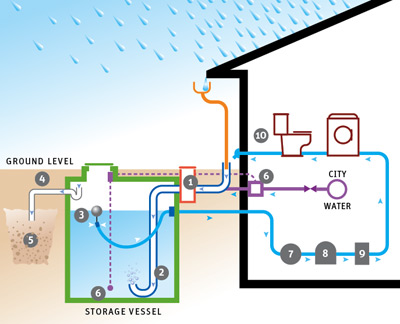
(Image from Stark Environmental- Thank you Michael.)
Ironically the water collection guy I have talked to the most about water systems is in PA.
Here is his info: Michael Stark, mstark@starkenvironmental.com, http://www.starkenvironmental.com/b-8-consultation.html
You may not be able to get into the second link without a password so I copied below. I DO NOT agree with 'Maritn' on this one - his claim - that saving water in places with plenty of water is a waste of time- I feel is in correct. We are all going to be in a water crisis soon enough and what we do actually effects the whole world...for real scientific reasons - not just good karma!
Green Building Advisor Link:
Grey water filtration system I have a customer requesting the installation of a grey water filtration/recycling system. The customer lives in the DC area and has explained that these systems are common and considered "green" in application in the urban DC area. The home I will be building for the customer is in the rural mountains of West Virginia. There is no shortage of water up here we have received close to 35" this year to date and average about 60" a year. We are looking to make budget decisions on "green" components. I admit I know little about these systems and have not talked to a plumber around here yet that doesn't say it is a waste of money. Is a grey water filtration/recycling system still "green" in an area that sees no water issues or will the system have a bigger footprint in terms of excess materials, maintenance, etc? ASKED BY JOSEPH GARTEN POSTED SUN, 05/22/2011 - 10:47
Answers newest to oldest oldest to newest:
You are probably better off using rainwater catchment over gray water. The water is much more pure, it needs minimal filtration and the entire system requires much less maintenance. Health codes generally restrict gray water to use in toilets and underground irrigation, while rainwater can be used for almost any use, including potable water (with proper filtration) and spray irrigation. The cost per gallon for rainwater is significantly less than gray water in terms of both first cost and ongoing maintenance. It may be appropriate to pipe the drains and toilet supplies for gray water even if you don't install the system initially. If higher performance gray water systems become available, then you can always install one, and having separate supply lines to toilets and laundry will allow you to use either rainwater or a future gray water system with minimal extra effort. ANSWERED BY CARL SEVILLE, GBA ADVISOR Posted Sun, 05/22/2011 - 19:31 2.
Joseph, Good green design and building doesn't follow a cookie-cutter checklist developed for a national audience. I agree with your implied criticism of greywater recycling systems for houses in high-rainfall areas: they don't make a lot of sense. Each climate has its own challenges. Where I live in northern Vermont, for example, water is plentiful, but warm days are few. In this climate, a very good thermal envelope designed to retain heat is an important green feature. Features designed to save water are much less important. Of course, in parts of Arizona or New Mexico, my priorities would be reversed. ANSWERED BY MARTIN HOLLADAY, GBA ADVISOR Posted Mon, 05/23/2011 - 04:53
Thanks for responses. I was thinking along the same lines Martin. What I am really thinking though...how green can you be if your building an elaborate vacation home in a poor rural community? Things are getting pretty twisted....green washing. ANSWERED BY JOSEPH GARTEN Posted Sun, 05/29/2011 - 19:31
Already February!
I can't believe it is mid -February and we have barely had winter this year!
I think everyone is feeling hopeful in 2012. So far Trillium is off to a bubbling start with lots of new home renovation jobs and a couple of new modern green homes on the boards.
Remember - just because your realtors tell you modern doesn't sell doesn't mean it's true. I have so many clients who walk in the door and say 'what I really want is a modern home, but my realtor tells me I can't build one.' No! It may not be the biggest market but there truly is a market for houses that are a bit more 'dwell magazine'. And we love to design them!
We will start posting more images of what we are working on soon...here is one for now~
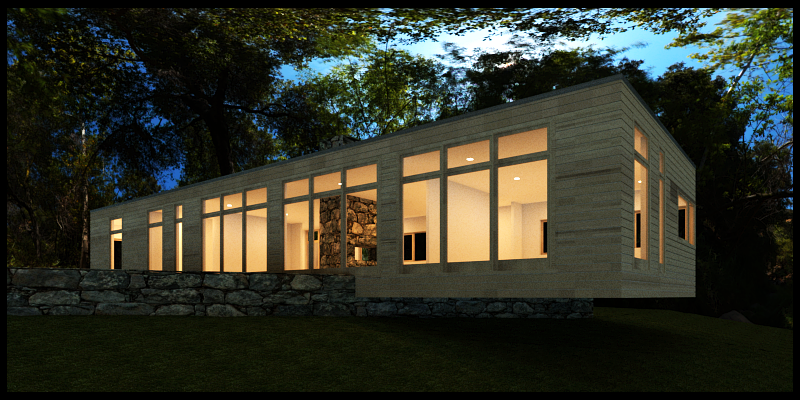
In the mean time Happy non-winter/ almost spring/ new year and happy renovating!
Elizabeth
Building a Hybrid Wall
I am one of the 'Pro's' on the Green Home Guide Website and as so I answer technical questions every month regarding green building. It is a very informative site!
Here is a link: http://greenhomeguide.com/
Below is one of my most recent question/answer's:
Q: New Construction, is a hybrid system the way to go for a 2x6 walls, 1 inch foam and the rest blown cellulose? Hybrid system vs just blown in cellulose for 2x6?
Asked by Scott
Paw Paw, MI
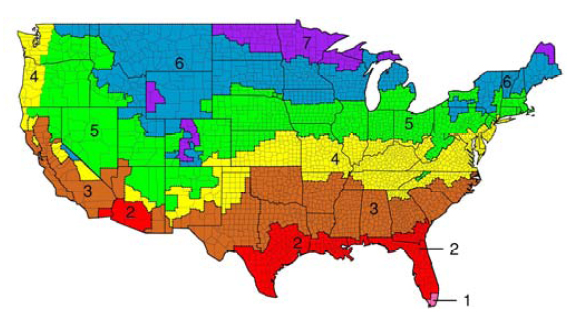
Hi Scott
As an Architect who designs only sustainable homes I am always a fan of the hybrid wall. But you have to do it right. You climate will heavily influence the type of hybrid wall you should build.
I see that Paw Paw, MI is in climate zone 5 but the northern edge of climate zone 5.
I live and work at the southern edge of climate zone 5 and a lot of our work falls to climate zone 4 or is right on the edge of 5 and 4.
Why am I saying all of this? Basically there is a ratio of exterior foam board insulation to interior cavity insulation that is ideal to achieve a great thermal envelope and at the same time avoid issues of moisture and mold occurring within the wall cavity. Basically the warmer the climate zone, the less exterior vs interior insulation you need to avoid air travelling into the wall cavity, reaching the dew point and turning into moisture.
So, in Zone 4 you can easily get away with 1 inch of polyiso rigid board insulation on the outside (about an R5) and 2x6 walls on the inside filled with foam or cellulose or some other cavity insulation. But when you get to Zone 5 you will get into trouble when you do that. In my area (southern Zone 5) you need at least an R7.5 (generally speaking) which is about an inch and a half. As you get more northern you need more- up to 2 or 2 ½ inches of rigid foam to your interior wall cavity.
The ironic thing is that – because this is all about the ratio of exterior to interior- if you build a 2x4 wall you need less exterior insulation. But in the colder climates what is the point of that? If you do that you significantly reduce the overall R value of your wall.
The biggest complication of putting more than 1” of rigid insulation on the exterior turns out to be construction. If you are only using 1” you can shoot your siding right through that to the stud beyond and it really does not complicate the construction process.
However if you are using more than an inch you have to introduce battens on top of the rigid insulation and lag through to the studs beyond and then attach your siding to the battens. (If you are using lap siding this is simple- battens are vertical to allow water to run down the wall, lap siding fastens horizontally across. But if you are using shingles or vertical panels you have to add horizontal nailers on top of the vertical battens and then attach shingles, panels etc. This is called a rain screen. There is more labor and a bit more material cost (battens are cheap).
This is a GREAT wall. Probably the best wall you can get. You get a lot of continuous insulation around the house plus you have an air space (the rainscreen) between you siding and the house itself. This air space makes the siding and the siding’s finish (no matter what kind of siding) last longer and require a lot less maintenance/ painting. If there is enough money in the job I will always go for this wall.
In your northern climate you deserve this wall! Your house will perform really well and you would not be sorry.
Another way to do the wall (my friends in Minnesota do this sort of wall primarily) is to simply build a double wall. Maybe a 2x4 wall, then a 2 “ gap, then another 2x4 wall. Fill the whole thing with whatever insulation you like. Cuts thermal bridging and you avoid the ratio issue.
One big factor of getting your wall to perform well is to focus on air infiltration as well as R Values. Some insulations like spray foams and rigid foam boards have their own innate air barrier properties, whereas batt and loose fill insulations like cellulose, cotton batt, blown fiberglass, etc do not. If you use one of the latter you should also pay very close attention so sealing all air gaps in the wall assembly. (You should do so with the foams as well, of course. There are simple less gaps in the foamed walls. ) That is a whole other topic.
In summing up- hybrid walls are great, you just have to do them right. There is a lot of information and complexity to true building science. You can usually get more help form one of your local green building professional to talk through your exact project. Just make sure whomever you talk to really knows their stuff and didn’t just recently become ‘green’ for marketing reasons!
Best of luck!
Elizabeth DiSalvo, Architect
To Window or Not To Window?
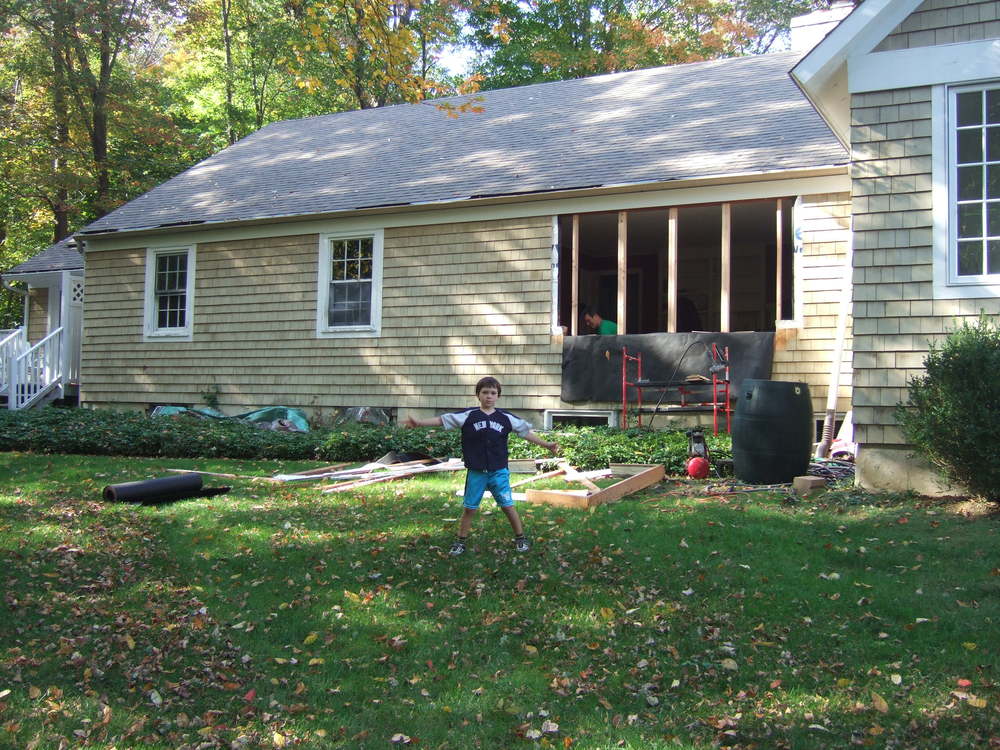 To Window or Not to Window?
To Window or Not to Window?
In the News!
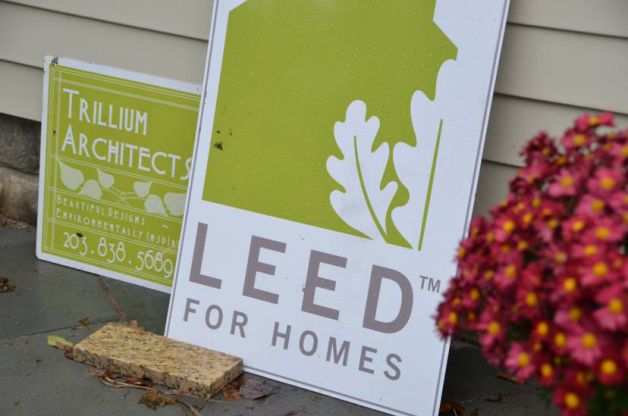
Our latest LEED Registered home was featured in the Darien News last week! We were happy to spread the word about living alternatively in Fairfield County. More and more people of wealth are considering a simpler life style with a smaller carbon footprint. You can read here about a family who chose to build a smaller home and to make it as clean and green as they possibly could! We love the story behind this house and the process was such a great experience for everyone involved that we hold it up as the model for what we think every home building experience should replicate.
Here is the link:
Enjoy!
Elizabeth
Farmer's Market!

We had a great time at the Westport Farmer's Market today! The Westport Market is perhaps the most established and respected markets in Fairfield County. Amazing produce! Delicious food! Interesting and purposeful people.
We spent four hours talking to visitors about prioritizing their green home renovations. So much fun to talk to such an educated and conscientious group. People of such conviction and compassion are truly our very best clients! We encourage everyone we spoke with to give us a call when you are ready to do some renovating! We would love to work with you!
We will be at the market once a month next summer and will likely appear at the Winter Market too. Look for us there and please stop by and say hi!
http://westportfarmersmarket.com/
What Has the World Become?
I hate to get so heavy on the first day back to reality after summer has ended but I really need to talk about the sate of the world. I realize that this may turn some potential clients off but I guess that is the risk I take for taking a firm stance.
The last few weeks of the summer have been weird to say the least. Weird is a bad word but what is another word? 'Unexpected', 'abnormal', 'troubling', 'disorienting', 'disheartening', hmmm so many plausible alternatives.
Here in the North East we had both an earthquake and a hurricane in the last 2 weeks. Unexpected! These two events both truly re-enforce the concept that global climate change is having an effect on our weather patterns and we should probably do something about it. Even people who have always poo-poo-ed (or aggressively denied) global warming are now basically admitting that there is something afoot with the weather and if we keep on with our current trajectory we could be having some really big problems really pretty soon. This too me is scary, but honestly I have been 'on this page' for so long it doesn't make me freak out- it just makes me know that we are on the right track in trying to make an effort to build homes with smaller and smaller carbon footprints. Though, really, I think these effort are still not enough - not nearly enough! At least we are trying to do things in the right direction.
Also the stock market and politics have both been absolute roller coasters of insanity with basically the feeling (or the plain old knowledge) that no one is at the helm of this ship. None of our leaders or experts seem to have any better idea than you or I of what is going on or how to fix it. Terrifying.
What is really making my head spin lately, however, is a different shift that has happened over the last 10 years. It is the ever growing rift between rich and poor, and the ever increasing sense of entitlement and shallowness in our society. It seems like the only people who get financially rewarded in our world anymore are people who are either in the financial industry or people who become super starts on TV - for whatever reason, no matter how stupid and empty. This is really such a sad state of affairs.
I am personal friends with people who are artists, doctors, writers, scientists, deep thinkers, musicians, sculptors, dancers, contractors, builders, craftsman, brilliant inventors,marketing people, teachers, clergy, firemen, police, nurses, and yes architects (the list goes on and on) and it is getting so that almost none of us make a decent living relative to our neighbors. Hell sometimes we don't make a decent living, period. Never mind the people who have always had to work super hard just to get by- you know- the road crew, the people who clean your house and serve your food and do your laundry and mow your lawn and pick up your trash?
It is like the frog in the hot water story. You know the one - you put a frog in a pot of cool water and slowly heat the water and before he even realizes that the water is too hot the poor guy is cooked all the way thru. I used to feel guilty because I wasn't getting rich being an architect. I used to feel like I was doing something wrong. I now see things in a totally new light. This water has been getting warmer and warmer these last 5 - 10 years for all of us people I listed above. Our jobs - the creative and thoughtful, the needed, the very difficult and the extremely dirty, and yes often very meaningful or brilliant work we all do quietly on a daily basis is being utterly disrespected financially....and socially.
I see it paralleling directly the state of affairs in which our society finds itself. It is a state of shallow and empty disrepair. A state in which there is no respect for creativity, art, spirituality, the making of things, helpfulness, caring, and certainly not an honest days labor. I heard the results of a survey recently in which teenagers were asked to prioritize a list of 10 things in the order in which they valued them. You got it- fame and money were the top of the list. Being a good person, doing the right thing, being true to your self and morals were the bottom of the list. Ugh. how really, really sad.
Maybe this is all more evident in Fairfield County and other very wealthy parts of the country.
Isn't it time that we made efforts to correct the course of this ship?
We design houses that bring families together and focus more on time with your loved ones instead of time with the computer or tv alone in your room. We design houses that let people connect with the world outside and the changing of the seasons. We make more from less. We help people use less. We find true, honest products and natural textures and nooks and crannies and light open airy-ness to inspire the soul and the mind. We do this all for a reason! We are trying to bring some balance back to the world. Some connection- to each other and to the planet.
We here at Trillium and the contractors, designers and craftspeople we work with all care. We care a lot. We all do very honest good work and we expect this work we do to be recognized and appreciated. Sometimes it is, sometimes it is not.
I have a great deal of respect for our clients in the financial industry who in turn respect all of the hard work that the rest of us do and who see that the direction of the world could be troubling, and so put a lot of their own work and money behind very helpful causes that frankly the rest of us cannot afford to put our money into. There are so many people in Fairfield County and beyond who make a difference. Shouldn't we all (and I mean all of us) try to do our best to make the world a more meaningful and respectful place for all people?
I believe that starts not with simply respecting our environment but respecting the people - all people- who live and work hard amongst us every day to try to bring meaning and value back to this world.
Darien LEED Home: Supporting Local Industry

Trillium Architects' newly constructed Darien home is green in many ways. Aside from being a LEED registered home due to receive LEED Platinum status upon completion, the house is full of not only sustainable materials, but also locally crafted materials. Here is a breakdown:
FURNITURE + FABRICS:
~ The built-in furniture (frames and upholstery) was made in Cheshire, CT, with all organic or natural fabrics free of flame retardants and heavy metals. The built-in seating cushion stuffing is an organic latex from Massachusetts. The Dining Room table and Master Bed frame will be made by a craftsman in Bethel, CT.
~ The window treatments for the home were made of all organic fabrics (Belgian and Italian linen) by a stay-at-home mom in Trumbull, CT.
LIGHTING, DOORS, ETC.:
~ Many of the interior light fixtures were made in Brooklyn, NY.
~ The window hardware was hand-forged by a Massachusetts blacksmith.
~ A single 100 foot spruce tree from the existing property was a hazard, leaning in on the house- ready to fall and in need of removal. From this tree, all of the window and door trim for the house's interior was produced.
~ The custom Dutch doors were created and insulated by a craftsman in Fairfield, CT.
PLUS!
~The crew of contractors on site made a promise to be good neighbors throughout the construction process. (Easy for these guys! They are 'great neighbors' before any promises are necessary). This promise included things like no smoking on the site, no littering, and watching out for the small children who lived - very closely- on each side of the job site. These guys would never have done anything but. You have never seen such happy neighbors who just lived through a 10 month construction job!



